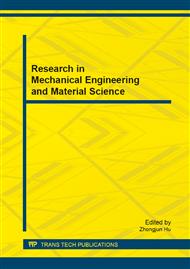p.3
p.10
p.14
p.18
p.22
p.28
p.32
p.38
p.43
An Optiming Process Design for Sinking with the Thin-Wall Cylindrical Cup
Abstract:
The sinking process with thin-walled cylindrical is a new method, which will be used to produce complicated automobile parts. However, in the process of cylinder sinking, there are some defects: wrinkling at the end, compressive instability on the cylinder wall and buckling at the top. These defects are affected by the forming parameters such as material properties, the friction coefficientμ, the die semi-cone angle α, the reduction ratio Rf/R0 .This paper has analyzed the influence of aforementioned parameters on the sinking process design, and a new method, multi-step sinking process, is presented. And optimizing the process design by using the theoretical analysis and FEM respectively, a more practical process scheme is gained through FEM, which has less steps, which could shorten the process-developed cycle, raise the productive efficiency and decrease the production cost.
Info:
Periodical:
Pages:
22-27
Citation:
Online since:
October 2013
Authors:
Keywords:
Price:
Сopyright:
© 2014 Trans Tech Publications Ltd. All Rights Reserved
Share:
Citation:


